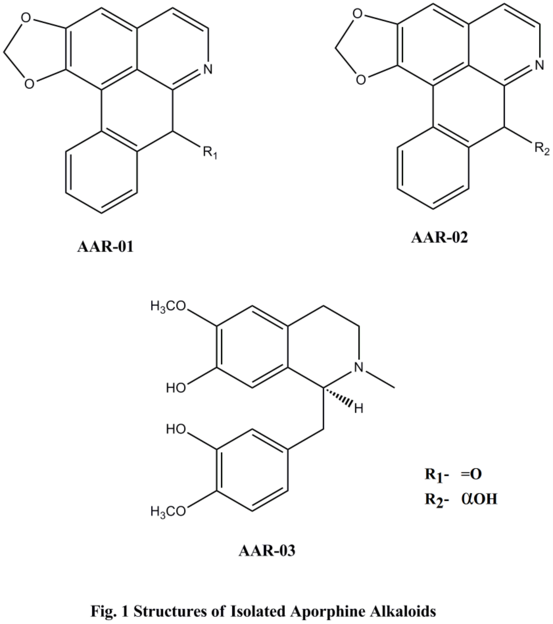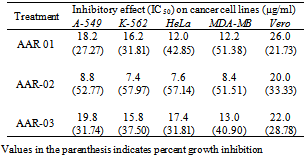-
Paper Information
- Next Paper
- Previous Paper
- Paper Submission
-
Journal Information
- About This Journal
- Editorial Board
- Current Issue
- Archive
- Author Guidelines
- Contact Us
International Journal of Plant Research
p-ISSN: 2163-2596 e-ISSN: 2163-260X
2012; 2(3): 57-60
doi: 10.5923/j.plant.20120203.02
Cytotoxicity of Aporphine Alkaloids from the Roots of Annona Reticulata on Human Cancer Cell Lines
H M Suresh 1, B Shivakumar 2, S I Shivakumar 3
1Department of Pharmacognosy,HKE Society’s, College of Pharmacy, Gulbarga 585 105, India and Department of Biotechnology, Acharya Nagarjuna University, Guntur, Andhra Pradesh, India
2Department of Pharmaceutical Chemistry, BLDEA’s College of Pharmacy, Bijapur 586 103, Karnataka, India
3Department of Pharmacology, HKE Society’s, College of Pharmacy, Gulbarga 585 105, India
Correspondence to: H M Suresh , Department of Pharmacognosy,HKE Society’s, College of Pharmacy, Gulbarga 585 105, India and Department of Biotechnology, Acharya Nagarjuna University, Guntur, Andhra Pradesh, India.
| Email: |  |
Copyright © 2012 Scientific & Academic Publishing. All Rights Reserved.
Phytochemical and pharmacological activities of Annona reticulata components suggest a wide range of clinical application in lieu of cancer therapy. Present study includes investigation of bioactive constituents from roots of Annona reticulata for cytotoxic properties against different cancer cell lines. Three aporphine alkaloids liriodenine (AAR-01), norushinsunine (AAR-02) and reticuline (AAR-03) isolated from the roots of Annona reticulata. The structures of the compounds were established by 1HNMR, 13CNMR and Mass spectral analysis. All the isolated compounds subjected for cytotoxicity evaluation against A-549, K- 562, HeLa, MDA-MB cancer cell lines and normal cell lines (Vero cells) by MTT assay. All the isolated compounds exhibited prominent dose-dependent cytotoxicity against all the cancer cell lines at dilutions 5, 10 and 20 μg/ml, whereas AAR-02 showed strong cytotoxicity against cancer cell lines with IC50 values ranging from 7.4 to 8.8 µg/ml. Simultaneously, the effect of all the isolated compounds against Vero cell lines was lower in comparison with the cancer cell lines. The prominent cytotoxicity of three aporphine alkaloids viz liriodenine (AAR-01), norushinsunine (AAR-02) and reticuline (AAR -03) may be because of isoquinoline moiety in their structures. The appearance of hydroxyl group at C-7 in AAR-02 could be favorable for increased cytotoxicity against cancer cell lines and lower cytotoxicity against Vero cell line seems that the aporphine alkaloids (AAR-01, AAR-02 and AAR-03) may be used as chemopreventive agents in cancer therapy.
Keywords: Annona Reticulata, A-549, K- 562, Hela, Mda-Mb, Vero Cell Lines, Mtt Assay
Article Outline
1. Introduction
- Aporphine is one of a class of quinoline alkaloids widely distributed among the plants of annonaceae family. Many potent relatives of this compound have been purified from the plants. They possess various pharmacological activities such as antiplatelet, antitumor, cytotoxic and antibacterial activities[1,2]. Cells of the body routinely grow and divide as and when the body needs them. This orderly process is disturbed when new cells form that the body was not needed and old cells don’t die when they should, leading to infinite multiplication and spread within the body of abnormal forms of the body’s own cells. These extra cells lump together to form a growth or tumour. Though cancer treatment by modern system of medicines using synthetic drugs is better, search for newer natural drugs continuesbecause of some complications like cell injury, bonemarrow depression, impair growth, sterility and hair loss associated with synthetic drugs[3]. Annona reticulata linn, commonly called as bullock’s heart or raamphal plant, is widely distributed all over India and are tall, with many branches, bearing nutritious fruits. The leaves are used as insecticides, anthelmintic, styptic and also used externally as suppurant. The bark as a powerful astringent is used as antidysenteric and vermifuge. Root bark, leaves and stem possess isoquinoline alkaloids[4]. In our early report, we investigated the in vitro antiproliferative activity of ethanol extract of roots against A-549, k- 562, HeLa and MDA-MB human cancer cell lines[5]. In continuation of our research work on evaluation of bioactive constituents from the roots of this plant for cytotoxic properties, three aporphine alkaloids liriodenine (AAR-01), norushinsunine (AAR-02) and reticuline (AAR -03) were isolated and evaluated for cytotoxicity against A-549, K-562, HeLa, MDA-MB and Vero cell lines by performingMTT[3-(4,5-dimethylthiazol-2-yl)-2,5-diphenyl tetrazolium bromide] colorimetric assay.
2. Materials and Methods
- Plant MaterialThe roots of Annona reticulata were collected from local areas of north Karnataka and identified by Dr. Srinath Rao of Botany department, Gulbarga University, Gulbarga. A botanically authenticated voucher specimen (HGUG No. 5007) has been deposited at the botany department herbarium of the Gulbarga University, Gulbarga, India.Material and reagentMTT assay kit was purchased from Roche Applied Sciences, Germany. A-549 (Human lung carcinoma) , K-562 (Human chronic Myelogenous Leukemia Bone Marrow), HeLa (Human Cervix) and MDA- MB (Human Adenocarcinoma Mammary Gland) and Vero (African green monkey kidney Normal cell) cell lines, free from any bacterial and fungal contamination were procured from NCCS , Pune. All the chemicals and reagents viz Propanol (Qualigens), Fetal Bovine Serum (Bioclot) and MTT dye were used for the study.Extraction and isolationAir dried and coarsely pulverized roots (2 kg) of Annona reticulata extracted with ethanol (95 %). The obtained extract was concentrated to dryness in a rota evaporator at room temperature to obtain ethanol extract (600 gm). About 50 gm of concentrated ethanol extract with 2× 250 ml petroleum ether (40 -60 0) to separate the fats. The complete defatted marc obtained after extraction was dried and made alkaline with 2× 250 ml ammonium hydroxide (NH4OH) and filtered. The alkaline filtrate further fractionated with 4× 250 ml of chloroform. The organic fractions were pooled and together made alkaline with ammonium hydroxide (NH4OH) washed with water, dried and the solvents removed to yield gummy residue (20 gm). It was partitioned with dichloromethane to remove the neutral components. This residue showed alkaloidal composition on TLC and further used for isolation of alkaloids by column chromatography (neutral alumina) using solvent system toluene: ethyl acetate: diethyl amine (70: 20: 10). Elution carried out gave a light brown colored substance. After washed with methanol, it was recrystallised from MeOH: acetone (1:1) to give (AAR- 01) pale yellow mass (101 mg).Elution further carried with chloroform: diethylamine (9:1) resulted with another single alkaloidal compound. After removing solvent from the mixed fraction, a residue resulted as a mixture of alkaloid compound which was pale mass (477 mg) followed by rechromatography on alumina bed using solvent system petroleum ether-chloroform (7: 3) afforded two pure alkaloid compounds designated as AAR- 02 pale brown amorphous powder (116 mg) and AAR -03 yellow amorphous mass (99 mg).Liriodenine (AAR -01) Pale yellow powder (C2H5OH), MS m/z: 274 [M + H] +. 1HNMR (400 MHz, CDCl3) : δ 9.14 (1H,s, NH) ,9.24 – 7.0 (6H, m, aromatic protons), 6.8 (2H, d, O-CH2-O). 13CNMR (100 MHz, CDCl3) δ 179.22 (C-6), 179.127, (C-5), 165.618 (C-2), 164.506 (C-1), 135.9 (C-13), 135.5 (C-12), 135.5 (C-15), 132.4 (C-9), 129.2 (C-14), 129.17 (C-7), 129.1(C-10), 125.6 (C-8), 124.5 (C-4), 119.6 (C-16), 118.3 (C-17), 104.3 (C-3), 101.2 (C-11)Norushinsunine (AAR-02) Light brown solid mass (C2H5OH), MS m/z: 280[M + H] +. 1HNMR (400 MHz, CDCl3) : δ 6.6 (2H, d, OCH2) , 4.0 - 7.9 (11H, m, aromatic protons), 3.9 (1H, s, C-OH), 1.7 (1H, s, NH). 13CNMR (100 MHz, CDCl3) δ 139.5 (C-2), 138.5 (C-1), 137.8 (C-14), 129.0 (C-15), 128.9 (C-9), 125.8(C-8), 123.3 (C-12), 120.2 (C-10), 118.30 (C-17),115.0 (C-7), 111.0 (C-16), 100.0 (C-3),78.07 (C-11), 70.9 (C-6), 62.8 (C-13), 43.3 (C-5), 31.2 (C-4).Reticuline (AAR-03) Yellow powder (C2H5OH), MS m/z: 329[M + H] +1HNMR (400 MHz, CDCl3): δ 6.6- 8.3 (6H, m, aromatic protons), 5.7 (2H, d, OH), 3.2 (6H, m, OCH2), 1.2-2.8 (9H, m, protons of rings CH2 and side chain CH2).13CNMR (100 MHz, CDCl3) δ 161.3 (C-10), 160.30 (C-9), 158.4 (C-3), 150.7 (C-2), 149.2 (C-15), 129 (C-16), 119.8 (C-13), 117.4 (C-12), 103.7 (C-8), 89.6 (C-1), 79.6 (C-11), 79.3 (C-14), 59.2 (C-17 & C-18), 58.2 (C-6), 52.13 (C-19), 51.0 (C-7), 42.6 (C-4), 41.3 (C-5).
 | Figure 1. Structures of Isolated Aporphine Alkaloids |
3. Results and Discussion
|
5. Conclusions
- In summary, the results of the present study provides convincing evidence that the aporphine alkaloids present in the roots of Annona reticulata may be one of the responsible compounds for cytotoxicity potential against cancer cell lines. The increased cytotoxicity of AAR- 02 reveals the importance of appearance of hydroxyl group at C-7 in 7-substituted aporhine alkaloids than others and can be used as a prototype for the development of new synthetic / semi-synthetic analogues for cancer treatment. However, the less prominent cytotoxic effect of isolated compounds on Vero cell line seems that these compounds (AAR-01, AAR-02 and AAR-03) may be used as chemopreventive agents in cancer therapy. However, the precise mechanism by which they exert this effect needs further investigations.
ACKNOWLEDGEMENTs
- We thank Dr. S. Appalaraju, Principal HKES’s Matoshree Taradevi Rampure Institute of Pharmaceutical Sciences, Gulbarga for encouragement and support in research.
 Abstract
Abstract Reference
Reference Full-Text PDF
Full-Text PDF Full-Text HTML
Full-Text HTML